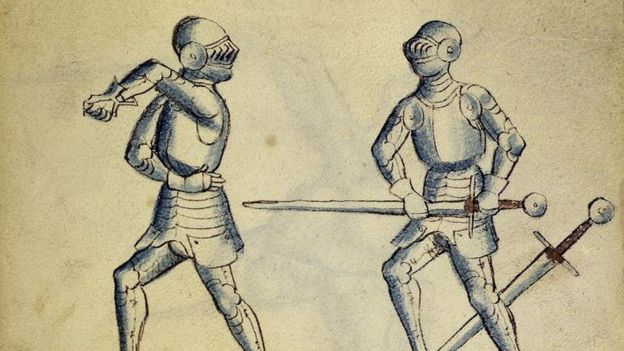daftandbarmy
Army.ca Dinosaur
- Reaction score
- 32,220
- Points
- 1,160
En garde!
In fact, many modern assumptions about how knights fought probably don't hold up. One is the elegance of sword fights, which were nothing like the depictions on television or even in medieval literature. In theory, knights were bound by the code of chivalry – a set of standards for how to behave fairly on the battlefield. And yet, according to Grant, these lofty ideals often weren't even honoured even in theory, let alone in practise.
"Certainly Fiore [de'l Liberi] knows what a fair fight looks like and he wants no part of it," says Grant. "The important thing is it's about making sure you're the one alive in the end. If that means pulling dirty tricks, 'Okay, great. Go for it.'"
In fact, there are hints that real-world combat would have been shockingly barbaric. Grant points to the insights provided by medieval skeletons, which show that fights rarely occurred on a blow-by-blow basis, at least in war – they were messy, rapid, and often involved several men attacking a single adversary simultaneously.
"What happens is you get a good strike into somebody's head and they go down under a flurry of blows," he says. "…very commonly what you'll see [on the skull] is they have six head wounds, of which two or three will probably be fatal. The second you're off balance, your opponent is going to follow up and they're going to be on top of you – they're going to keep hitting."
However, despite the large gaps between modern re-enactments and historical reality, MacIver is undeterred. He's optimistic that – irrespective of inevitable mistakes – the ancient fight masters would approve of what Hema enthusiasts are attempting. After all, some recorded their secrets exactly because they wanted to avoid them being lost.
As di Vadi explained 540 years ago, he wrote his own fight book so that the ancient techniques he learned "do not disappear through my negligence". Though it's very much a work in progress, you could say he's on track to achieving this goal.

 www.bbc.com
www.bbc.com
The lost medieval sword fighting tricks no one can decode
In fact, many modern assumptions about how knights fought probably don't hold up. One is the elegance of sword fights, which were nothing like the depictions on television or even in medieval literature. In theory, knights were bound by the code of chivalry – a set of standards for how to behave fairly on the battlefield. And yet, according to Grant, these lofty ideals often weren't even honoured even in theory, let alone in practise.
"Certainly Fiore [de'l Liberi] knows what a fair fight looks like and he wants no part of it," says Grant. "The important thing is it's about making sure you're the one alive in the end. If that means pulling dirty tricks, 'Okay, great. Go for it.'"
In fact, there are hints that real-world combat would have been shockingly barbaric. Grant points to the insights provided by medieval skeletons, which show that fights rarely occurred on a blow-by-blow basis, at least in war – they were messy, rapid, and often involved several men attacking a single adversary simultaneously.
"What happens is you get a good strike into somebody's head and they go down under a flurry of blows," he says. "…very commonly what you'll see [on the skull] is they have six head wounds, of which two or three will probably be fatal. The second you're off balance, your opponent is going to follow up and they're going to be on top of you – they're going to keep hitting."
However, despite the large gaps between modern re-enactments and historical reality, MacIver is undeterred. He's optimistic that – irrespective of inevitable mistakes – the ancient fight masters would approve of what Hema enthusiasts are attempting. After all, some recorded their secrets exactly because they wanted to avoid them being lost.
As di Vadi explained 540 years ago, he wrote his own fight book so that the ancient techniques he learned "do not disappear through my negligence". Though it's very much a work in progress, you could say he's on track to achieving this goal.

The lost medieval sword fighting tricks no one can decode
No one knows how medieval knights really fought.

